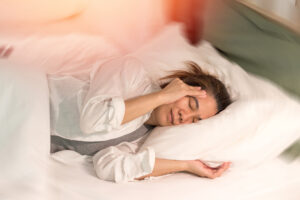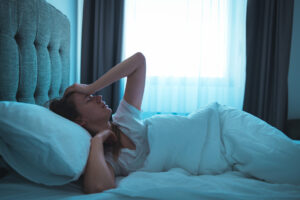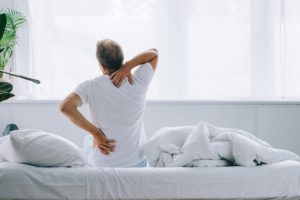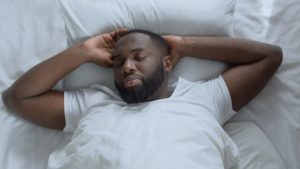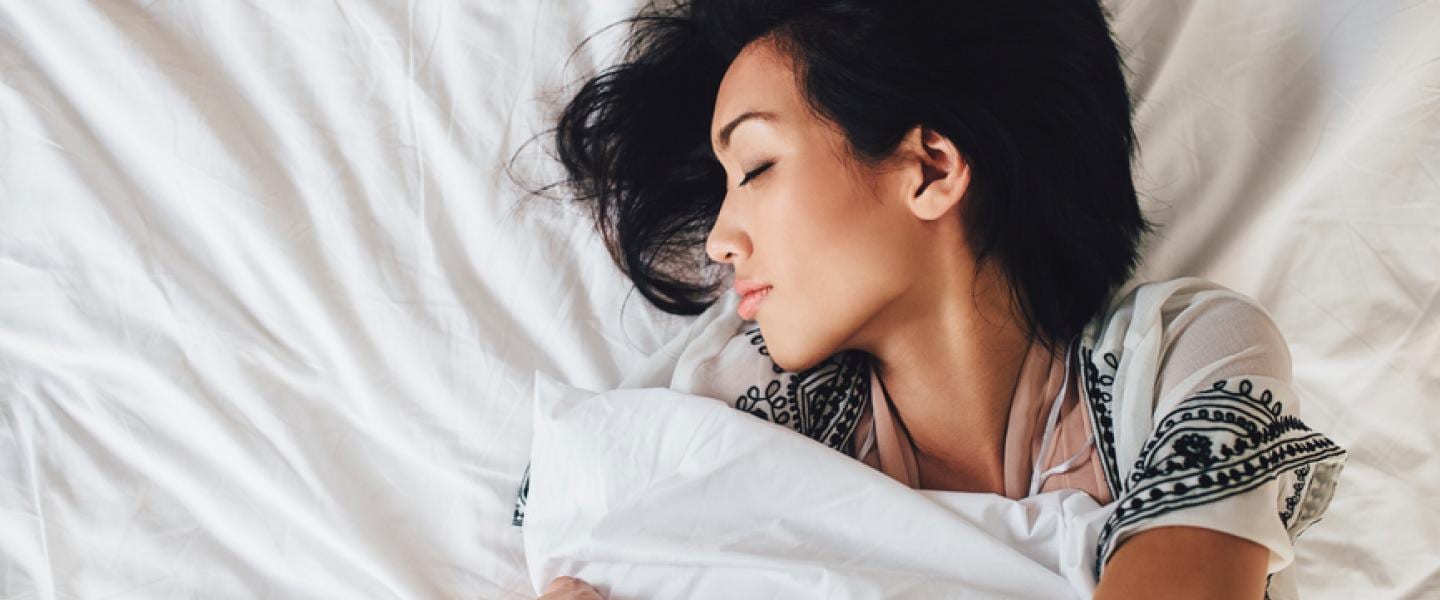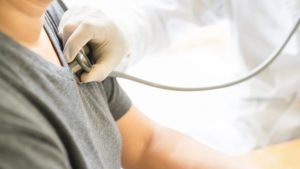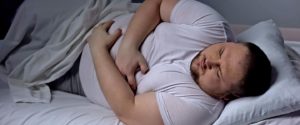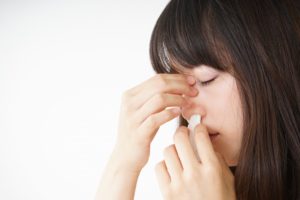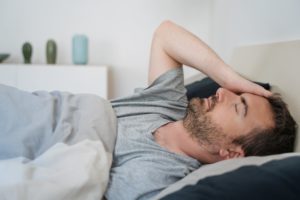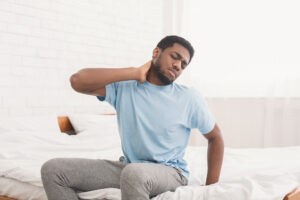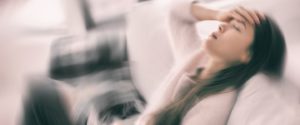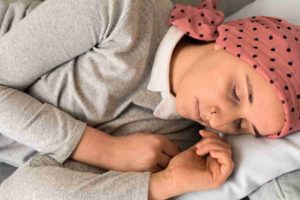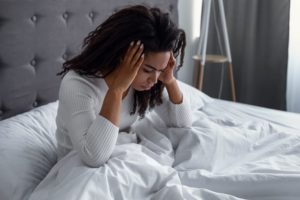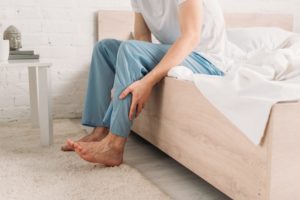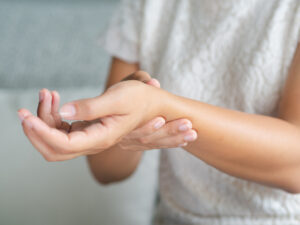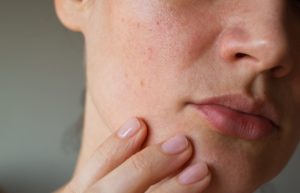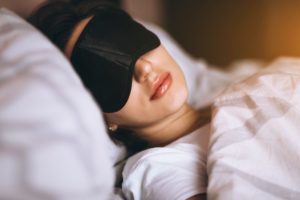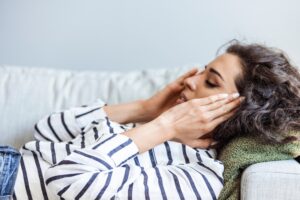When you buy through our links, we may earn a commission. Products or services may be offered by an affiliated entity. Learn more.
Sleeping With Your Eyes Open
Closing your eyes is a defining feature of sleep. For that reason, it may be surprising to learn that some people sleep with their eyes partially or fully open. This condition, known as nocturnal lagophthalmos, is relatively common. Research studies indicate that about 1 in 20 people do not shut their eyes while sleeping.
Why Do We Close Our Eyes During Sleep?
Our eyelids play an important role in getting a good night’s sleep. Eyelids act as a protective barrier, keeping the eyes safe from debris. They also provide lubrication and prevent the eyes from drying out.
Closing our eyes also blocks light, which is crucial for calibrating the body’s internal 24-hour clock. Specific cells in the retina process light and send information to the hypothalamus, signaling that it’s time to be awake. When we experience darkness, melatonin is produced, telling our body it’s time to sleep.
What Causes You to Sleep With Your Eyes Open?
Nocturnal lagophthalmos can have many causes, including faulty eyelid mechanics, facial nerve disorders, and structural changes in the face. Numerous conditions can predispose individuals to these issues:
- Proptosis (Bulging Eyeball): When the eyeball protrudes, it creates more surface area for the eyelids to cover. Possible causes of proptosis include thyroid disorders like Graves disease, congenital conditions affecting the anatomy of the face, an infection, or a tumor.
- Short or Weak Eyelids: Numerous conditions can either shorten the eyelids or decrease their muscle tone, thereby preventing the eyelids from fully closing. Medical procedures like eyelid-tightening surgery, Botox injection, and fat removal around the eyes can compromise eyelid height and tone.
- Scarring: Physical trauma, chemical burn, and certain diseases such as ocular pemphigoid and Stevens-Johnson syndrome, can scar components of the eyelids and limit their function.
- Nerve Problems: A range of problems affecting facial nerves can prevent the eyelids from functioning properly. These problems include Bell’s palsy, Lyme disease, and injuries.
- Sedatives: Excessive alcohol and sedatives, including some sleeping pills, can sometimes cause nocturnal lagophthalmos.
- Idiopathic: When there is no known cause for nocturnal lagophthalmos, it is classified as idiopathic.
In some circumstances, a person’s eyes can be open while they’re asleep without it meaning they have nocturnal lagophthalmos. For example, people who sleepwalk frequently have their eyes open during sleepwalking episodes. However, sleepwalking is considered a separate issue from nocturnal lagophthalmos.
Signs You May Be Sleeping With Your Eyes Open
Not everyone with nocturnal lagophthalmos notices symptoms. The symptoms a person experiences depend on the severity of the condition and a person’s age. Because ocular lubrication mitigates the drying effect of nocturnal lagophthalmos, older adults are more likely to have symptoms due to age-related reduction in tear quality and production.
Nocturnal lagophthalmos symptoms are usually the worst in the morning and improve over the course of the day. Possible symptoms include:
- Dry eyes
- Sore or painful eyes
- A feeling of irritation
- Watery eyes
- Blurry vision
- Red eyes
Over time, nocturnal lagophthalmos may damage the cornea from persistent dryness — a condition called keratitis — and increase the risk of corneal ulcers, perforation, and vision loss .
Studies have found that people who experience nocturnal lagophthalmos have poor sleep quality , mostly likely due to discomfort. Some research indicates that the light entering through open eyelids causes sleepers to awaken from visual stimulation .
Diagnosing Lagophthalmos
If a doctor suspects nocturnal lagophthalmos, they typically begin the diagnostic process by observing the eyes from a distance. They also thoroughly discuss symptoms, predisposing conditions, and family history with the person experiencing symptoms.
Based on the initial consultation, the doctor may recommend a slit lamp examination. This procedure uses a low-power microscope to examine structures in the eye. The doctor may also ask the person experiencing symptoms to blink, and use gloved hands to move the eyelids and check for signs of nerve dysfunction.
A special assessment is often done since this is an important component of developing a patient’s treatment plan.
Treatment for Sleeping With Your Eyes Open
The treatment given for nocturnal lagophthalmos varies depending on its cause and the severity of symptoms. If possible, it is important to correct any underlying condition contributing to the problem. For example, a person with nerve damage might consult a neurologist, or someone with a thyroid disorder may require endocrine therapy.
The first goal of treating nocturnal lagophthalmos is to improve dry-eye and prevent keratitis . People experiencing symptoms may be given eye drops to provide lubrication for waking hours and an ointment for bedtime. In more severe cases, doctors may recommend using special tape to keep the eyes shut at night, or a goggle-like device that provides moisture during sleep.
If you’re diagnosed with nocturnal lagophthalmos, it may be appropriate to make adjustments to your sleeping environment to counteract its effects. Make sure the room is kept dark so that light does not enter and contribute to awakenings. Using a humidifier or moving your bed away from dry airflow can also lessen dry-eye.
People experiencing nocturnal lagophthalmos are encouraged to limit alcohol or sedatives before bed. It’s also important to keep the eyes clean and free of debris since insufficient lubrication increases the risk of infection. People with nocturnal lagophthalmos might find it helpful to practice blinking more frequently and fully during waking hours to ensure the eyes have sufficient moisture.
Some people may require surgical intervention to treat nocturnal lagophthalmos. Relevant surgical techniques include skin grafting, sewing the eyelids closer together, or implanting tiny gold weights in the eyelids. Although these approaches may sound drastic, they are generally well-tolerated and effective.
When To Talk to Your Doctor
Nocturnal lagophthalmos can be hard to diagnose on your own. Even if another person observes you while you sleep, very small eyelid openings may be obscured by eyelashes and go undetected.
If you’re having persistent eye symptoms, particularly dry-eye that is worse in the morning, it may be helpful to see a doctor for specialized testing. If left untreated, nocturnal lagophthalmos can significantly affect your eye health and compromise sleep. Getting a proper diagnosis and tailored treatment plan will help you get the quality shut-eye you need.

Still have questions? Ask our community!
Join our Sleep Care Community — a trusted hub of sleep health professionals, product specialists, and people just like you. Whether you need expert sleep advice for your insomnia or you’re searching for the perfect mattress, we’ve got you covered. Get personalized guidance from the experts who know sleep best.
References
9 Sources
-
National Institute of Neurological Disorders and Stroke. (2019, August 13). Brain basics: Understanding sleep.
https://www.ninds.nih.gov/health-information/public-education/brain-basics/brain-basics-understanding-sleep -
Tsai, S. H., Yeh, S. I., Chen, L. J., Wu, C. H., & Liao, S. L. (2009). Nocturnal lagophthalmos. International Journal of Gerontology, 3(2), 89–95.
https://www.sciencedirect.com/science/article/abs/pii/S1873959809700274 -
Nambi, G. I., Beck, B., & Gupta, A. K. (2010). An unusual cause of lagophthalmos. Oman Journal of Ophthalmology, 3(1), 32–33.
https://pubmed.ncbi.nlm.nih.gov/20606872/ -
A.D.A.M. Medical Encyclopedia [Internet]. Atlanta (GA): A.D.A.M., Inc.; c1997-2019. Sleepwalking., Retrieved June 15, 2021, from
https://medlineplus.gov/ency/article/000808.htm -
Fu, L., & Patel, B. C. (2021). Lagophthalmos. StatPearls. StatPearls Publishing.
https://pubmed.ncbi.nlm.nih.gov/32809496/ -
Waller, E. A., Bendel, R. E., & Kaplan, J. (2008). Sleep disorders and the eye. Mayo Clinic Proceedings, 83(11), 1251–1261.
https://pubmed.ncbi.nlm.nih.gov/18990324/ -
Takahashi, A., Negishi, K., Ayaki, M., Uchino, M., & Tsubota, K. (2020). Nocturnal lagophthalmos and sleep quality in patients with dry eye disease. Life (Basel, Switzerland), 10(7), 105.
https://pubmed.ncbi.nlm.nih.gov/32635438/ -
Pereira, M. V., & Glória, A. L. (2010). Lagophthalmos. Seminars In Ophthalmology, 25(3), 72–78.
https://pubmed.ncbi.nlm.nih.gov/20590416/ -
A.D.A.M. Medical Encyclopedia. (2018, September 30). Dry eye syndrome. MedlinePlus., Retrieved May 27, 2021, from
https://medlineplus.gov/ency/article/000426.htm





